Bordeaux Bucketlist: Where Old Heritage meets Sparkling Innovation
Having undergone a major facelift over the last few years, the city of Bordeaux, in Gironde, is really coming into its own.
Long known as France’s ‘Sleeping Beauty’, Bordeaux is a city that has well and truly woken up in recent years. In fact, it feels like the slumbering princess has had a double espresso, a big Bordelais brunch and a major makeover – and is ready now to take on the world.
It all began when the former mayor, Alain Juppé, set about giving the city a much-needed facelift. As well as cleaning up the buildings’ blackened façades, he pedestrianised key areas and introduced a pioneering wireless-tram system.
In addition, an ambitious project was launched to rejuvenate the neglected quaysides along the river. Meanwhile, the right bank has also undergone a major renovation, with the inauguration of the Darwin eco-village – and, back on the left bank, one of the country’s largest urban development projects, Euratlantique, is still under way.
Then, of course, there was the opening of the new high-speed train link to Paris, making it possible to reach the capital in just over two hours. Any time now, the latest stretch of tramline will also be completed, connecting the airport directly with the city, and another new bridge will open next year. There’s even talk of installing cable cars to carry people across the river.
Read More: Why Bordeaux is the European Capital of Smart Tourism
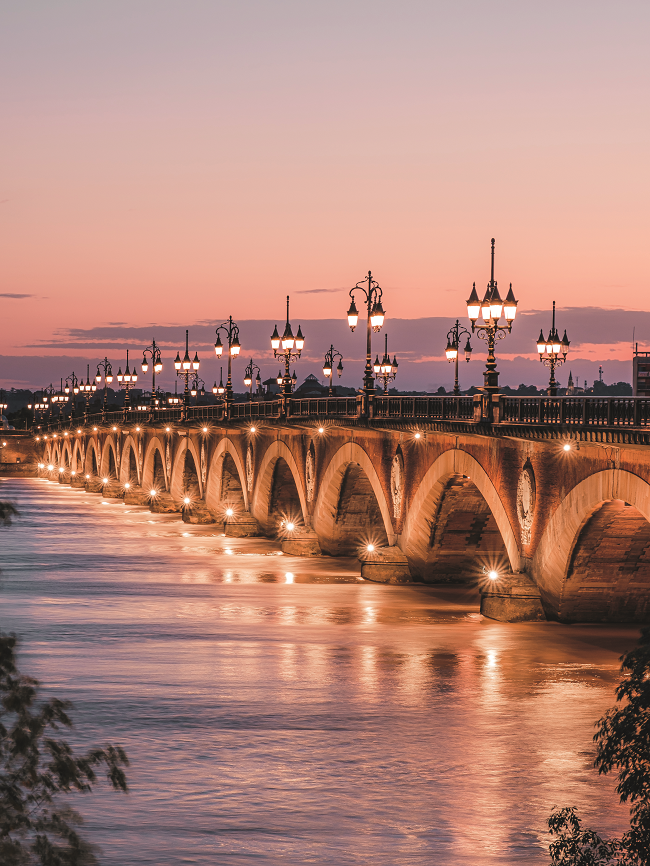
With the river at its heart, Bordeaux is a city of picture-perfect views © Teddy Verneuil
A rich heritage
Nonetheless, for all this innovation, the Bordeaux of old is still very much in evidence – just looking a little more resplendent these days. After Paris, the city has the most protected buildings in France – and, in 2007, its exceptional architecture, comprising the Port de la Lune, became the largest urban area to receive UNESCO World Heritage status.
A city that has long been shaped by the wine industry, and latterly by the colonial trade, it was in the 18th century that Bordeaux became the wealthy and bourgeois place that we recognise now. By that stage, it was the country’s leading port, and a host of impressive buildings were constructed around this time.
Today, while there is the beautiful architecture, luxury shopping and high-end hotels, Bordeaux is also a progressive, slightly left-field city with a Green mayor, Pierre Hurmic, and a rich counter-culture seen in the street art, alternative shops and surf/skate scene. Known for its easy- going, southern vibe, the first sign of spring sunshine sees locals gathering for lunches in the small squares or, as the sun sinks behind the honey-coloured buildings, for an evening apéro with friends.
Read More: Top 10 Things to Do in Bordeaux
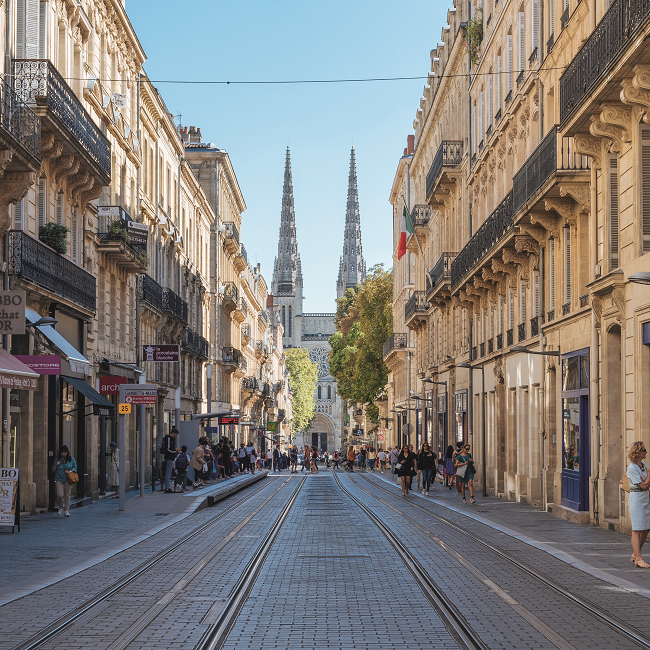
There is a pretty view around every corner in the city of Bordeaux © Nicolas Duffaure
The old town
For first-time visitors to Bordeaux, there is no better place to begin than the historic heart of the city – the districts of Saint-Pierre and Saint-Paul – where the narrow, winding streets follow the same pattern as in the 13th century. Although many of the original buildings have been replaced by elegant 18th-century constructions, the area still retains something of its medieval ambience.
If anyone has read the Fighting Fantasy gamebooks, such as City of Thieves, it feels a bit like that. Adding to the sense of magic are the mythological mascarons – decorative carved-stone faces – adorning the walls. Unlike in the books, however, the small, shady thoroughfares suddenly spit you out, blinking in the sunshine, into charming squares where tables and chairs spread out over the cobbles. Among the most picturesque spots for a breather is Place Saint-Pierre, shaded by sweet-chestnut trees, with its Gothic church. Alternatively, Place Camille Jullian, setting for the much-loved indie Cinéma Utopia, is a favourite with locals – or another popular one is Place du Palais, next to the Porte Cailhau gate, once a main entrance to the city. Speaking of which, five of the old city gates remain today, marking the original perimeter walls. Dating from the 15th century, the Porte Cailhau and Grosse Cloche are the oldest, and both look like they’re straight out of a fairy tale. The latter is also one of the oldest belfries in France.
Read More: Three Days in Bordeaux

The 15th-century bell tower, the Grosse Cloche, is straight out of a fairy tale © Caroline Harrap
Bordeaux bucketlist
The first thing on most people’s Bordeaux bucket list, however, is usually Place de la Bourse, a majestic arc of neoclassical architecture from the 18th century. It’s also the setting for the largest water mirror in the world, reflecting the grandiose buildings behind, and an essential stop for an Insta-snap.
Another popular destination is Rue Sainte-Catherine, the longest pedestrian shopping street in Europe at 1.2km. Away from the chain stores, the side streets are full of interesting independents often selling locally-made products. Hidden behind department store Galeries Lafayette, Place Puy Paulin provides a calm place for a coffee.
At the top of Rue Sainte-Catherine is the city’s most iconic square, Place de la Comédie. Famed for its 18th-century opera house, the Grand-Théâtre, it’s also the setting for the five-star Inter Continental hotel, where Gordon Ramsay has a Michelin two-star restaurant. The surrounding streets of the ‘Golden Triangle’ are studded with luxury brands.
Read More: 8 Best Day Trips from Bordeaux
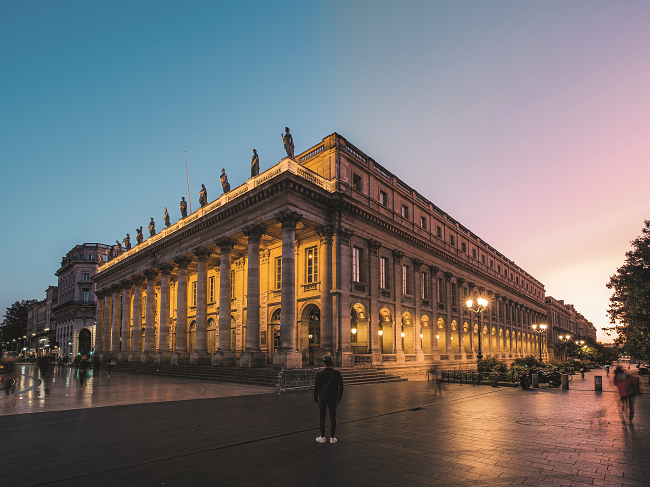
One of the city’s most famous buildings, the Grand-Théâtre, home to the national opera © Teddy Verneuil
A diverse district
For something a little different shopping-wise, head south into the Saint-Michel area. A highlight here is the antiques/vintage hub, Les Brocanteurs du Passage Saint-Michel, spread over two levels and with its own café/restaurant. The famed flea market every Sunday is a bargain-hunter’s paradise.
One of the city’s most vibrant and diverse districts, Saint- Michel was once the haunt of arriving seafarers. Despite the growing gentrification, it retains its multicultural roots in its varied food offering. Alternatively, the nearby covered market of Capucins showcases local specialities.
At the heart of the Saint-Michel neighbourhood is its Gothic basilica, built between the 14th and 17th centuries and listed by UNESCO. Standing beside it, the bell tower is the tallest in southwest France, at 114m, but is currently clad in scaffolding as it undergoes restoration.
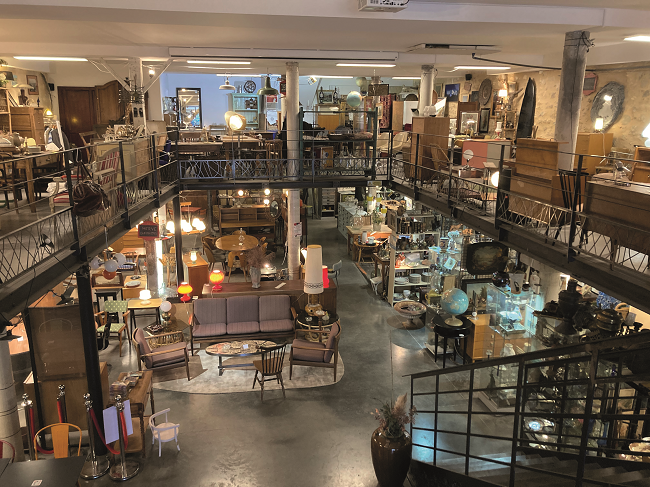
For lovers of antiques or anything vintage, Les Brocanteurs du Passage Saint Michel is a must © Caroline Harrap
A panoramic view
For now, the best place for a panoramic view is the Pey- Berland bell tower, which dates from the 15th century and is classified as a Monument Historique. Following a climb of 229 steps up a steep spiral staircase, there is a rather narrow access door, so go easy on the canelés beforehand. It’s worth it, though, for the spectacular 360° vista over the city.
The square here is home to no less than three classified monuments. As well as the tower itself, there’s the Gothic cathedral of Saint-André, dating mainly from the 13th and 14th centuries, and the impressive Palais Rohan, now the city hall, built in the 18th century. Take a pause at Le Café Français, a traditional brasserie from 1899, to soak it all up.
A short tram ride to the north, the picturesque district of Chartrons was once the main centre for the city’s wine trade. Today, this serene neighbourhood feels rather more like a village, and at its core is the long and leafy street, Rue Notre- Dame, lined with independent boutiques, art galleries and antique and bric-a-brac stores.

With its serene surrounds, the Chartrons district feels more like a village than being in a city © Nicolas Duffaure
Maritime memories
As well as its architectural heritage, the city is notable for its rich nautical history. To discover this, head to the docks just north of Chartrons, the Bassins à Flot, where a maritime museum opened in 2019. In recent years, this former industrial area has given way to cultural sites, restaurants and bars – though few can beat the atmospheric setting of the IBoat, a former ferry, with a concert/club space, canteen and terrace.
At the centre of it all is the huge hulking slab of concrete that dominates the district. A former submarine base built by the Germans during the Second World War, it is now home to the Bassins des Lumières, the largest digital art gallery in the world, with monumental artworks projected across the walls and water. Akin to being submerged in a giant kaleidoscope, the latest exhibition sees the works of Gaudí and Dalí set to a soundtrack that includes Pink Floyd and The Doors. An enjoyable walk along the water brings you to another celebrated attraction, the futuristic Cité du Vin, devoted to the world of wine. Recently reopened with a newly designed permanent exhibition, the museum is also set to launch a sensory exhibition focused on tasting. Just opposite is a gourmet food market, Les Halles de Bacalan, where purchases can be eaten at wooden benches.
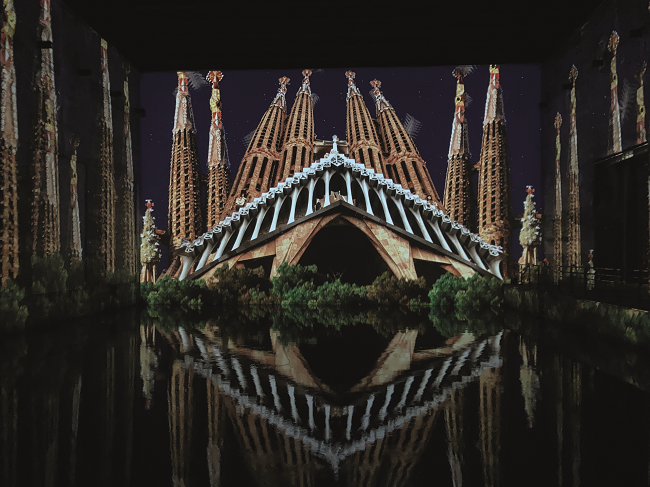
The latest exhibition at Les Bassins des Lumières features the works of Gaudi and Dali © Caroline Harrap
A bright future
Looking ahead, things show no sign of slowing down either. Among several notable hotel openings, the design-led four- star, FirstName, with its stylish bar, in Mériadeck has already been drawing acclaim. Elsewhere, a swathe of new restaurants includes one devoted to the culinary heritage of refugee and immigrant women, Marie Curry, in Saint-Michel. Then there’s the new covered food market opening near the station.
The coming months will also see several international sports events heading to Bordeaux. As well as the Tour de France passing through in early July, the city will host five Rugby World Cup matches in September. Next year, the Olympic Games will arrive, with several football matches held here.
There are even rumours of a new London-to-Bordeaux Eurostar. In any event, with the Sleeping Beauty wide awake, there’s certainly a buzz about Bordeaux just now – making it the ideal time to visit.
From France Today Magazine

The rooftops of Bordeaux illuminated by the southern sun © Cyril Cosson
Lead photo credit : The iconic place de la Bourse © Steve Le Clech Photos
Share to: Facebook Twitter LinkedIn Email
More in Bordeaux, city breaks, French cities, Nouvelle-Aquitaine, short breaks
Leave a reply
Your email address will not be published. Required fields are marked *



